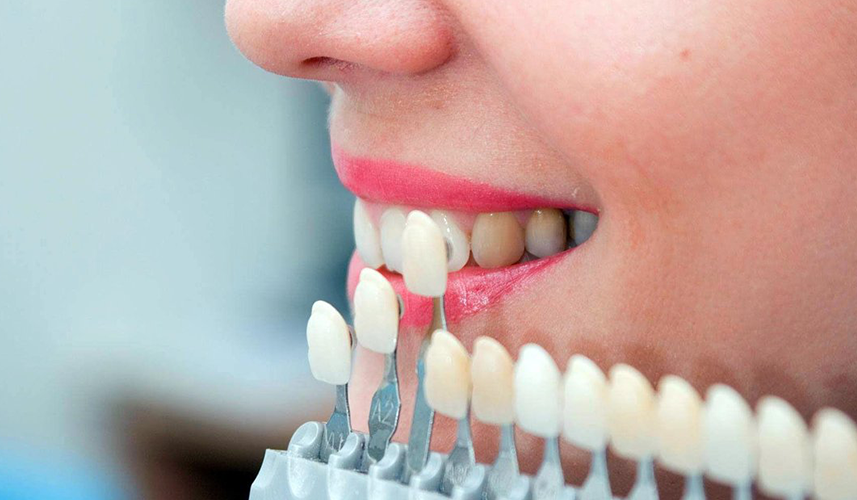Dental veneer treatment is a dentistry procedure applied for the aesthetic and functional improvement of teeth. Dental veneers are thin and custom-made materials that are bonded to the front surface of the teeth. This treatment is used to change the color, shape, size or length of the teeth and to correct aesthetic defects in the teeth. Dental veneers, which are usually made of porcelain or composite resin materials, are very similar to the appearance of natural teeth and are a long-lasting solution.
Purpose and Areas of Use of Dental Veneer Treatment
The main purpose of dental veneer treatment is to improve the appearance of the teeth aesthetically and functionally. This treatment method can be used to solve various dental problems. Dental veneers are especially preferred in the following cases:
Discoloration: Permanent stains or color changes that cannot be removed with teeth whitening treatments can be covered with dental veneers. Veneers make the teeth look whiter and brighter.
Dental Deformities: Crooked, irregular or worn teeth can be corrected with veneers. Veneers make the teeth look more regular and symmetrical.
Interdental Spaces: The spaces between teeth (diastema) can be closed with veneers. This helps to achieve a more aesthetic smile.
Cracks and Fractures: Cracked or broken teeth can be repaired with veneers. This restores both the appearance and functionality of the tooth.
Size and Length Corrections: Teeth that are too short or irregular in size can be brought to the desired size with veneers. This provides a more balanced and aesthetic smile.
Dental Veneer Treatment Process
Dental veneer treatment is usually performed in several stages, and this process may vary depending on the needs of the patient and the evaluations made by the dentist. In general, the dental veneer treatment process includes the following steps:
Examination and Planning: In the first stage, the dentist evaluates the patient's teeth and general oral health. A treatment plan is created considering the patient's wishes and needs. The condition of the teeth is examined in detail using X-rays and other imaging techniques.
Preparation: The teeth where the dental veneers will be placed need to be prepared. In this stage, a thin layer is taken from the front surface of the teeth. This is important so that the veneers fit the natural teeth and do not create a thick appearance. After the teeth are prepared, molds are created in the laboratory to make the veneers by taking precise measurements.
Temporary Veneers: While permanent veneers are being prepared, temporary veneers can be used to protect the teeth and maintain the aesthetic appearance. Temporary veneers help the patient protect their teeth and eat comfortably.
Placing the Veneers: When the permanent veneers are ready, the dentist bonds the veneers to the teeth. At this stage, the color and shape of the veneers are checked and any necessary corrections are made. The veneers are fixed to the teeth using a special adhesive and finally, the veneers are hardened with light to ensure they fit perfectly.
Advantages of Dental Veneer Treatment
Dental veneer treatment offers many advantages and is therefore a popular option in the field of aesthetic dentistry. The main advantages are:
Aesthetic Appearance: Dental veneers have an almost identical appearance to natural teeth and provide excellent aesthetic results.
Durability: Porcelain veneers are particularly durable and long-lasting. With proper care, they can be used for years.
Color Stability: Porcelain veneers are resistant to stains and remain white for a long time.
Fast Results: Dental veneer treatment can usually be completed in a few weeks and provides an aesthetic smile quickly.
Disadvantages and Care of Dental Veneer Treatment
There are also some disadvantages to dental veneer treatment. First of all, the treatment is irreversible since some of the tooth enamel needs to be removed. In addition, the veneers can break or crack over time, in which case they may need to be replaced. A good oral hygiene routine is essential to extend the life of dental veneers. Regular brushing of the teeth, flossing, and regular dentist check-ups ensure that the veneers last a long time.
In conclusion, dental veneer treatment is an effective treatment method that improves the appearance and health of the teeth both aesthetically and functionally. It helps patients regain their smiles and increase their self-confidence. Dental veneers are a frequently preferred method in modern dentistry and offer many advantages in terms of aesthetics and durability.
